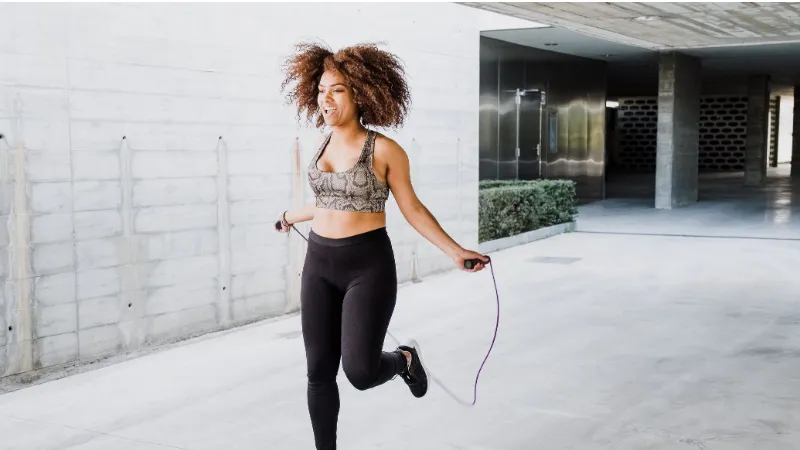
How long should a jump rope be? About three feet longer than you, a jump rope should be used. Step on the middle of your rope to hold it taut. The rope’s ends should rest against your armpit, excluding the handles.
Here’s the lengthy response, shall we. We’ll cover the ideal jump rope length, the reasons why jump rope length is important, and how to change your jump rope length.
How Long Should a Jump Rope Be: Things to Consider
Jumping ropes can be of any length. Every person has their ideal body size. To determine the proper jump rope length for you, there are some factors to consider. Each of these will assist in influencing your choice.
Height
You must first measure your jump rope length by height. The most crucial factor to take into account is this. In order to avoid falling over it or having it drag on the ground, your jumping rope must be the right size for you.
Add 1-3 feet to your height as a rule of thumb to remember. It does not scrape the floor, which could cause you to lose momentum, and provides enough space above your head.
Level of Skill
How skilled you are is another determinant for what jump rope size is best for you. Different rope sizes will yield different results and call for varying skill levels.
Your body is more compact if the head gap is smaller. This reduces fatigue in your muscles and lets you go faster but requires skill. Competent athletes would prefer it. Greater learning gaps are slower and more stressful, but learning them is easier. For beginners, this is preferable. Once you get better, you should eventually keep cutting the rope shorter.
Personal Fitness Goals
Are you an athlete preparing for a game or are you just trying to warm up and get some cardio in? Your chosen rope’s length and type will be heavily influenced by your fitness objectives.
A smaller head gap is preferred by an athlete practicing or competing in double-unders in order to increase speed and effectiveness. You only need to help activate your muscles during a warm-up; you are not expected to reach high speeds. The only requirement for a casual gym goer is to perspire.
Handle Length
The length of your jump rope handles, as strange as it may sound, also influences the choice of rope length. If you combine long handles with a long rope, the result will be a dragging rope because longer handles lengthen your rope and increase the diameter of your swing.

How to Measure a Jump Rope?
Step on the center of the rope and pull it taut to determine if the length is appropriate for you. The rope’s ends should (excluding the handles) extend to your armpits.
By putting the jump rope through its paces and measuring its performance, find the ideal length.
“If your cable keeps hitting your feet, it’s too short,” says Erin Oprea, Nashville-based trainer who has experience working with country music stars like Maren Morris and Carrie Underwood and is NESTA and AFAA certified
If the rope drags along the ground and slows the momentum, it’s probably too long.
There is a simple way to gauge how long your jump rope should be if you’re ordering one online.
“By adding three feet to your height, you can get a rope that is about the right length,” says Oprea.
Types of Jump Ropes
You’ll discover there are a seemingly endless number of jump rope options once you start shopping. Jump ropes can be made from a variety of materials, and each material has pros and cons.
Here are a few factors to consider:
- Terrain:A “rope” made from plastic-wrapped string won’t last long if you like to jump outside on unforgiving surfaces like pavement. On the other hand, a steel cable covered in vinyl will likely hold up better in rocky terrain.
- Rope thickness:In general, a thinner cable is better for speed while a thicker cable will be more robust.
- Weight:According to RX Smart Gear, which provides jump ropes for USA Boxing, advanced jumpers may prefer a lightweight cable to increase speed or a heavier cable to increase resistance.
How to Adjust Your Jump Rope?
You might be able to cut the rope shorter if it’s too long. (Not all ropes can be adjusted, but wire ropes frequently can.)
To adjust the length of the jump rope:
- Step on the center of the rope while holding the handles.
- The rope should be pulled tight. Without taking the handles into account, the rope should be at armpit height.
- Any extra length on each side should be cut off using wire cutters.
Frequently Asked Questions
Why Does Jump Rope Length Matter?
While a rope that is too short might not touch the ground, increasing the likelihood that a jumper will trip or fall, a rope that is too long will take longer to rotate, limiting your speed.
How Long Should a Jump Rope Be?
Choose a rope that is 3 feet taller than you as a general rule for beginners. Jumpers with more experience might prefer to use a shorter rope because it rotates more quickly and allows for faster jumps.
Conclusion
You are now equipped with the knowledge necessary to choose the ideal jump rope size for yourself. To determine your average length, use the chart or the manual method. While a beginner or casual athlete using a plastic rope should adhere to it, a professional athlete using a wire rope should slightly reduce that.
You also know how to size a jump rope. Use knots or adjustable jump ropes instead of snipping unless you’re positive you’re doing it correctly.
Are you an amateur fitness enthusiast or a professional athlete now? Which length would you prefer? Message me in the comments if I missed anything.



